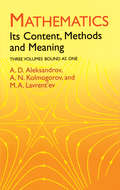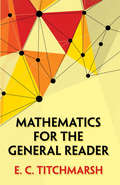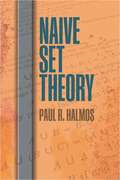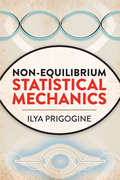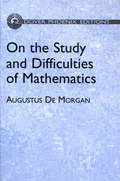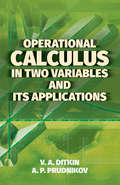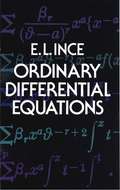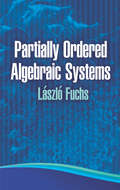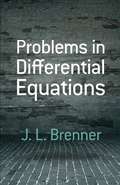- Table View
- List View
Mathematical Foundations of Information Theory (Dover Books on Mathematics)
by A. Ya. KhinchinThe first comprehensive introduction to information theory, this book places the work begun by Shannon and continued by McMillan, Feinstein, and Khinchin on a rigorous mathematical basis. For the first time, mathematicians, statisticians, physicists, cyberneticists, and communications engineers are offered a lucid, comprehensive introduction to this rapidly growing field.In his first paper, Dr. Khinchin develops the concept of entropy in probability theory as a measure of uncertainty of a finite “scheme,” and discusses a simple application to coding theory. The second paper investigates the restrictions previously placed on the study of sources, channels, and codes and attempts “to give a complete, detailed proof of both … Shannon theorems, assuming any ergodic source and any stationary channel with a finite memory.”Partial Contents: I. The Entropy Concept in Probability Theory — Entropy of Finite Schemes. The Uniqueness Theorem. Entropy of Markov chains. Application to Coding Theory. II. On the Fundamental Theorems of Information Theory — Two generalizations of Shannon’s inequality. Three inequalities of Feinstein. Concept of a source. Stationarity. Entropy. Ergodic sources. The E property. The martingale concept. Noise. Anticipation and memory. Connection of the channel to the source. Feinstein’s Fundamental Lemma. Coding. The first Shannon theorem. The second Shannon theorem.
Mathematical Foundations of Quantum Mechanics (Dover Books On Physics Series)
by George W. MackeyDesigned for students familiar with abstract mathematical concepts but possessing little knowledge of physics, this text focuses on generality and careful formulation rather than problem-solving. Its author, a member of the distinguished National Academy of Science, based this graduate-level text on the course he taught at Harvard University.Opening chapters on classical mechanics examine the laws of particle mechanics; generalized coordinates and differentiable manifolds; oscillations, waves, and Hilbert space; and statistical mechanics. A survey of quantum mechanics covers the old quantum theory; the quantum-mechanical substitute for phase space; quantum dynamics and the Schrödinger equation; the canonical "quantization" of a classical system; some elementary examples and original discoveries by Schrödinger and Heisenberg; generalized coordinates; linear systems and the quantization of the electromagnetic field; and quantum-statistical mechanics.The final section on group theory and quantum mechanics of the atom explores basic notions in the theory of group representations; perturbations and the group theoretical classification of eigenvalues; spherical symmetry and spin; and the n-electron atom and the Pauli exclusion principle.
Mathematical Methods in the Theory of Queuing (Dover Books on Mathematics)
by A. Y. Khinchin D. M. Andrews M. H. QuenouilleWritten by a prominent Russian mathematician, this concise monograph examines aspects of queuing theory as an application of probability. The three-part treatment begins with a study of the stream of incoming demands (or "calls," in the author's terminology). Subsequent sections explore systems with losses and systems allowing delay. Prerequisites include a familiarity with the theory of probability and mathematical analysis. A. Y. Khinchin made significant contributions to probability theory, statistical physics, and several other fields. His elegant, groundbreaking work will prove of substantial interest to advanced undergraduates, graduate students, and professionals in the fields of statistics, probability, and operations research.
Mathematical Theory of Compressible Fluid Flow
by Richard Von MisesA pioneer in the fields of statistics and probability theory, Richard von Mises (1883-1953) made notable advances in boundary-layer-flow theory and airfoil design. This text on compressible flow, unfinished upon his sudden death, was subsequently completed in accordance with his plans, and von Mises' first three chapters were augmented with a survey of the theory of steady plane flow. Suitable as a text for advanced undergraduate and graduate students -- as well as a reference for professionals -- Mathematical Theory of Compressible Fluid Flow examines the fundamentals of high-speed flows, with detailed considerations of general theorems, conservation equations, waves, shocks, and nonisentropic flows.In this, the final work of his distinguished career, von Mises summarizes his extensive knowledge of a central branch of fluid mechanics. Characteristically, he pays particular attention to the basics, both conceptual and mathematical. The novel concept of a specifying equation clarifies the role of thermodynamics in the mechanics of compressible fluids. The general theory of characteristics receives a remarkably complete and simple treatment, with detailed applications, and the theory of shocks as asymptotic phenomena appears within the context of rational mechanics.
Mathematics: Its Content, Methods and Meaning (Dover Books on Mathematics)
by A. N. Kolmogorov A. D. Aleksandrov M. A. Lavrent’evThis major survey of mathematics, featuring the work of 18 outstanding Russian mathematicians and including material on both elementary and advanced levels, encompasses 20 prime subject areas in mathematics in terms of their simple origins and their subsequent sophisticated developement. As Professor Morris Kline of New York University noted, "This unique work presents the amazing panorama of mathematics proper. It is the best answer in print to what mathematics contains both on the elementary and advanced levels."Beginning with an overview and analysis of mathematics, the first of three major divisions of the book progresses to an exploration of analytic geometry, algebra, and ordinary differential equations. The second part introduces partial differential equations, along with theories of curves and surfaces, the calculus of variations, and functions of a complex variable. It furthur examines prime numbers, the theory of probability, approximations, and the role of computers in mathematics. The theory of functions of a real variable opens the final section, followed by discussions of linear algebra and nonEuclidian geometry, topology, functional analysis, and groups and other algebraic systems.Thorough, coherent explanations of each topic are further augumented by numerous illustrative figures, and every chapter concludes with a suggested reading list. Formerly issued as a three-volume set, this mathematical masterpiece is now available in a convenient and modestly priced one-volume edition, perfect for study or reference.
Mathematics for the General Reader (Dover Books on Mathematics)
by E. C. TitchmarshThis highly accessible introduction to mathematics is geared toward readers seeking a firm grasp of the essentials of mathematical theory and practice. The treatment also offers a concise outline of mathematical history and a clearer notion of why mathematicians do what they do.Author E. C. Titchmarsh, who served for many years as Savilian Professor of Geometry at Oxford University, begins with counting and the fundamentals of arithmetic. He guides readers through the complexities of algebra, fractions, geometry, irrational numbers, logarithms, infinite series, complex numbers, quadratic equations, trigonometry, functions, and integral and differential calculus. Titchmarsh's graceful, fluid style helps make complicated topics easier to grasp, and his inclusion of numerous examples will prove especially helpful to readers with little or no background in mathematics.
The Mathematics of Games
by John D. BeasleyIf playing games is natural for humans, analyzing games is equally natural for mathematicians. Even the simplest of games involves the fundamentals of mathematics, such as figuring out the best move or the odds of a certain chance event. This entertaining and wide-ranging guide demonstrates how simple mathematical analysis can throw unexpected light on games of every type--games of chance, games of skill, games of chance and skill, and automatic games.Just how random is a card shuffle or a throw of the dice? Is bluffing a valid poker strategy? How can you tell if a puzzle is unsolvable? How large a role does luck play in games like golf and soccer? This book examines each of these issues and many others, along with the general principles behind such classic puzzles as peg solitaire and Rubik's cube. Lucid, instructive, and full of surprises, it will fascinate mathematicians and gamesters alike.
Matrix Vector Analysis (Dover Books on Mathematics)
by Richard L. EisenmanThis outstanding text and reference applies matrix ideas to vector methods, using physical ideas to illustrate and motivate mathematical concepts but employing a mathematical continuity of development rather than a physical approach. The author, who taught at the U.S. Air Force Academy, dispenses with the artificial barrier between vectors and matrices--and more generally, between pure and applied mathematics.Motivated examples introduce each idea, with interpretations of physical, algebraic, and geometric contexts, in addition to generalizations to theorems that reflect the essential structure. A combination of matrix and vector methods reinforces both techniques. "Applied" students learn that general theory is a natural and useful culmination of their computations, and "pure" students learn that concrete problems from the physical world have traditionally keynoted abstract intellectual pursuits.Geared toward upper-level undergraduates, the text features approximately 50 provocative problems at each chapter's end that test students' choice of techniques. Each chapter is also followed by about 25 mental exercises that stimulate imaginative reflection. Answers are given to selected questions.
The Method of Trigonometrical Sums in the Theory of Numbers (Dover Books on Mathematics)
by I. M. VinogradovSince the 1930s, the analytic theory of numbers has been transformed by the influence of I. M. Vinogradov, and this text for upper-level undergraduates and graduate students testifies to its author's ingenuity and to the effectiveness of his methods. Starting with a discussion of general lemmas, it advances to an investigation of Waring's problem, including explorations of singular series, the contribution of the basic intervals, and an estimate for G(n). Further topics include approximation by the fractional parts of the values of a polynomial, estimates for Weyl sums, the asymptotic formula in Waring's problem, the distribution of the fractional parts of the values of a polynomial, estimates for the simplest trigonometrical sums with primes, and Goldbach's problem. 1954 edition.
N-Person Game Theory: Concepts and Applications (Dover Books on Mathematics)
by Anatol RapoportN-person game theory provides a logical framework for analyzing contests in which there are more than two players or sets of conflicting interests-anything from a hand of poker to the tangled web of international relations. In this sequel to his Two-Person Game Theory, Dr. Rapoport provides a fascinating and lucid introduction to the theory, geared towards readers with little mathematical background but with an appetite for rigorous analysis.Following an introduction to the necessary mathematical notation (mainly set theory), in Part I the author presents basic concepts and models, including levels of game-theoretic analysis, individual and group rationality, the Von Neumann-Morgenstern solution, the Shapley value, the bargaining set, the kernel, restrictions on realignments, games in partition function form, and Harsanyi's bargaining model. In Part II he delves into the theory's social applications, including small markets, large markets, simple games and legislatures, symmetric and quota games, coalitions and power, and more.This affordable new edition will be welcomed by economists, political scientists, historians, and anyone interested in multilateral negotiations or conflicts, as well as by general readers with an interest in mathematics, logic, or games.
Naive Set Theory (Dover Books on Mathematics)
by Paul R. HalmosThis classic by one of the twentieth century's most prominent mathematicians offers a concise introduction to set theory. Suitable for advanced undergraduates and graduate students in mathematics, it employs the language and notation of informal mathematics. There are very few displayed theorems; most of the facts are stated in simple terms, followed by a sketch of the proof. Only a few exercises are designated as such since the book itself is an ongoing series of exercises with hints. The treatment covers the basic concepts of set theory, cardinal numbers, transfinite methods, and a good deal more in 25 brief chapters.
Non-Equilibrium Statistical Mechanics (Dover Books On Physics Series)
by Ilya PrigogineIlya Prigogine won the 1977 Nobel Prize in Chemistry for his contributions to non-equilibrium thermodynamics. This groundbreaking 1962 monograph, written for researchers and graduate students in this field, was his first book-length contribution to this subject. Suitable for advanced undergraduates and graduate students in physics and chemistry, the treatment begins with examinations of the Liouville equation, anharmonic solids, and Brownian motion. Subsequent chapters explore weakly coupled gases, scattering theory and short-range forces, distribution functions and their diagrammatic representation, the time dependence of diagrams, the approach to equilibrium in ionized gases, and statistical hydrodynamics. Additional topics include general kinetic equations, general H-theorem, quantum mechanics, and irreversibility and invariants of motion. Appendices, a bibliography, list of symbols, and an index conclude the text.
Non-Euclidean Geometry (Dover Books on Mathematics)
by Stefan KulczyckiThis accessible approach features two varieties of proofs: stereometric and planimetric, as well as elementary proofs that employ only the simplest properties of the plane. A short history of geometry precedes a systematic exposition of the principles of non-Euclidean geometry.Starting with fundamental assumptions, the author examines the theorems of Hjelmslev, mapping a plane into a circle, the angle of parallelism and area of a polygon, regular polygons, straight lines and planes in space, and the horosphere. Further development of the theory covers hyperbolic functions, the geometry of sufficiently small domains, spherical and analytical geometry, the Klein model, and other topics. Appendixes include a table of values of hyperbolic functions.
Non-Riemannian Geometry (Dover Books on Mathematics #8)
by Luther Pfahler EisenhartNon-Riemannian Geometry deals basically with manifolds dominated by the geometry of paths developed by the author, Luther Pfahler Eisenhart, and Oswald Veblen, who were faculty colleagues at Princeton University during the early twentieth century. Eisenhart played an active role in developing Princeton's preeminence among the world's centers for mathematical study, and he is equally renowned for his achievements as a researcher and an educator.In Riemannian geometry, parallelism is determined geometrically by this property: along a geodesic, vectors are parallel if they make the same angle with the tangents. In non-Riemannian geometry, the Levi-Civita parallelism imposed a priori is replaced by a determination by arbitrary functions (affine connections). In this volume, Eisenhart investigates the main consequences of the deviation.Starting with a consideration of asymmetric connections, the author proceeds to a contrasting survey of symmetric connections. Discussions of the projective geometry of paths follow, and the final chapter explores the geometry of sub-spaces.
Nonlinear Differential Equations (Dover Books on Mathematics)
by Raimond A. StrubleThis concise and widely referenced monograph has served as a text for generations of advanced undergraduate math majors and graduate students. Prepared with an eye toward the needs of applied mathematicians, engineers, and physicists, the treatment is equally valuable as a reference for professionals. After discussing some mathematical preliminaries, author Raimond A. Struble presents detailed treatments of the existence and the uniqueness of a solution of the initial-value problem, properties of solutions, properties of linear systems, stability in nonlinear systems, and two-dimensional systems. Additional chapters examine perturbations of periodic solutions and a general asymptotic method. Numerous exercises appear throughout the book, along with examples that contribute additional material, illustrate theorems and concepts, and provide a link with more practical aspects of the theory.
Nonlinear Transformations of Random Processes (Dover Books on Electrical Engineering)
by Ralph DeutschThis concise treatment of nonlinear noise techniques encountered in system applications is suitable for advanced undergraduates and graduate students. The book is also a valuable reference for systems analysts and communication engineers, as it discusses the basic mathematical theories of nonlinear transformations applied to random processes encountered in communications and control systems. Prerequisites include a familiarity with statistics, probability, complex variables, and Fourier and Laplace transforms. The first five chapters present specific classes of nonlinear devices and random processes that in combination lead to closed form solutions for the statistical properties of the transformed process. Subsequent chapters address techniques based on the use of series representations, general systematic approaches to the subject of nonlinear transformations of random processes, and sampling and quantizing a random process. A helpful Appendix features notes on hypergeometric functions.
Numerical Methods for Two-Point Boundary-Value Problems (Dover Books on Mathematics)
by Herbert B. KellerA concise, elementary yet rigorous account of practical numerical methods for solving very general two-point boundary-value problems. Directed to students with a knowledge of advanced calculus and basic numerical analysis, and some background in ordinary differential equations and linear algebra. More than 100 problems augment and clarify the textual material. 1968 edition.
On Formally Undecidable Propositions of Principia Mathematica and Related Systems (Dover Books on Mathematics)
by Kurt GödelIn 1931, a young Austrian mathematician published an epoch-making paper containing one of the most revolutionary ideas in logic since Aristotle. Kurt Giidel maintained, and offered detailed proof, that in any arithmetic system, even in elementary parts of arithmetic, there are propositions which cannot be proved or disproved within the system. It is thus uncertain that the basic axioms of arithmetic will not give rise to contradictions. The repercussions of this discovery are still being felt and debated in 20th-century mathematics.The present volume reprints the first English translation of Giidel's far-reaching work. Not only does it make the argument more intelligible, but the introduction contributed by Professor R. B. Braithwaite (Cambridge University}, an excellent work of scholarship in its own right, illuminates it by paraphrasing the major part of the argument.This Dover edition thus makes widely available a superb edition of a classic work of original thought, one that will be of profound interest to mathematicians, logicians and anyone interested in the history of attempts to establish axioms that would provide a rigorous basis for all mathematics. Translated by B. Meltzer, University of Edinburgh. Preface. Introduction by R. B. Braithwaite.
On the Study and Difficulties of Mathematics
by Augustus De MorganOne of the twentieth century's most eminent mathematical writers, Augustus De Morgan enriched his expositions with insights from history and psychology. On the Study and Difficulties of Mathematics represents some of his best work, containing points usually overlooked by elementary treatises, and written in a fresh and natural tone that provides a refreshing contrast to the mechanical character of common textbooks.Presuming only a knowledge of the rules of algebra and Euclidean theorems, De Morgan begins with some introductory remarks on the nature and objects of mathematics. He discusses the concept of arithmetical notion and its elementary rules, including arithmetical reactions and decimal fractions. Moving on to algebra, he reviews the elementary principles, examines equations of the first and second degree, and surveys roots and logarithms. De Morgan's book concludes with an exploration of geometrical reasoning that encompasses the formulation and use of axioms, the role of proportion, and the application of algebra to the measurement of lines, angles, the proportion of figures, and surfaces.
Operational Calculus in Two Variables and Its Applications (Dover Books on Mathematics)
by A. P. Prudnikov V. A. DitkinA concise monograph by two Russian experts provides an account of the operational calculus in two variables based on the two-dimensional Laplace transform. Suitable for advanced undergraduates and graduate students in mathematics, the treatment requires some familiarity with operational calculus in one variable.Part One of the two-part approach presents the fundamental theory in two chapters, examining the two-dimensional Laplace transform and offering basic definitions and theorems of the operational calculus in two variables and its applications. Part Two presents tables of formulae for various categories of functions, including rational and irrational functions; exponential and logarithmic functions; cylinder, integral, and confluent hypergeometric functions; and other areas.
Ordinary Differential Equations (Dover Books on Mathematics)
by Edward L. InceThe theory of ordinary differential equations in real and complex domains is here clearly explained and analyzed. Not only classical theory, but also the main developments of modern times are covered. Exhaustive sections on the existence and nature of solutions, continuous transformation groups, the algebraic theory of linear differential systems, and the solution of differential equations by contour integration are as valuable to the pure mathematician as the fine treatment of the equations of Legendre, Bessel, and Mathieu, the conditions for the oscillatory character of solutions of a differential equation, and the relation between a linear differential system and an integral equation are to the engineer and the physicist.Partial contents: real domain (elementary methods of integration, the existence and nature of solutions, continuous transformation-groups, linear differential equations-the general theory, with constant coefficients, solutions, algebraic theory, Sturmian theory, and later developments); complex domain (existence theorems, equations of first order, non-linear equations of higher order, solutions, systems, classifications of linear equations, oscillation theorems).
Partially Ordered Algebraic Systems (Dover Books on Mathematics)
by Laszlo FuchsOriginally published in an important series of books on pure and applied mathematics, this monograph by a distinguished mathematician explores a high-level area in algebra. It constitutes the first systematic summary of research concerning partially ordered groups, semigroups, rings, and fields. The self-contained treatment features numerous problems, complete proofs, a detailed bibliography, and indexes. It presumes some knowledge of abstract algebra, providing necessary background and references where appropriate. This inexpensive edition of a hard-to-find systematic survey will fill a gap in many individual and institutional libraries.
Plane Waves and Spherical Means: Applied To Partial Differential Equations (Dover Books on Mathematics)
by Fritz JohnElementary and self-contained, this heterogeneous collection of results on partial differential equations employs certain elementary identities for plane and spherical integrals of an arbitrary function, showing how a variety of results on fairly general differential equations follow from those identities. The first chapter deals with the decomposition of arbitrary functions into functions of the type of plane waves. Succeeding chapters introduce the first application of the Radon transformation and examine the solution of the initial value problem for homogeneous hyperbolic equations with constant coefficients and the problem of determining a function from its integrals over spheres of radius 1. 1955 edition.
Problems and Worked Solutions in Vector Analysis (Dover Books on Mathematics)
by L. R. Shorter"A handy book like this," noted The Mathematical Gazette, "will fill a great want." Devoted to fully worked out examples, this unique text constitutes a self-contained introductory course in vector analysis for undergraduate and graduate students of applied mathematics.Opening chapters define vector addition and subtraction, show how to resolve and determine the direction of two or more vectors, and explain systems of coordinates, vector equations of a plane and straight line, relative velocity and acceleration, and infinitely small vectors. The following chapters deal with scalar and vector multiplication, axial and polar vectors, areas, differentiation of vector functions, gradient, curl, divergence, and analytical properties of the position vector. Applications of vector analysis to dynamics and physics are the focus of the final chapter, including such topics as moving rigid bodies, energy of a moving rigid system, central forces, equipotential surfaces, Gauss's theorem, and vector flow.
Problems in Differential Equations (Dover Books on Mathematics)
by J. L. BrennerA supplement for elementary and intermediate courses in differential equations, this text features more than 900 problems and answers. Suitable for undergraduate students of mathematics, engineering, and physics, this volume also represents a helpful tool for professionals wishing to brush up on their problem-solving skills.The book is divided into twenty sections, each preceded by a clear and logical explanation of the basic ideas needed for solving the problems within the section. Many fully explained illustrative problems appear throughout the text. Subjects include applied routine and nonroutine problems in vibrations, electrical engineering, mechanics, and physics. Stars indicate advanced problems. Short mathematical and numerical tables are provided at the end of the book.




